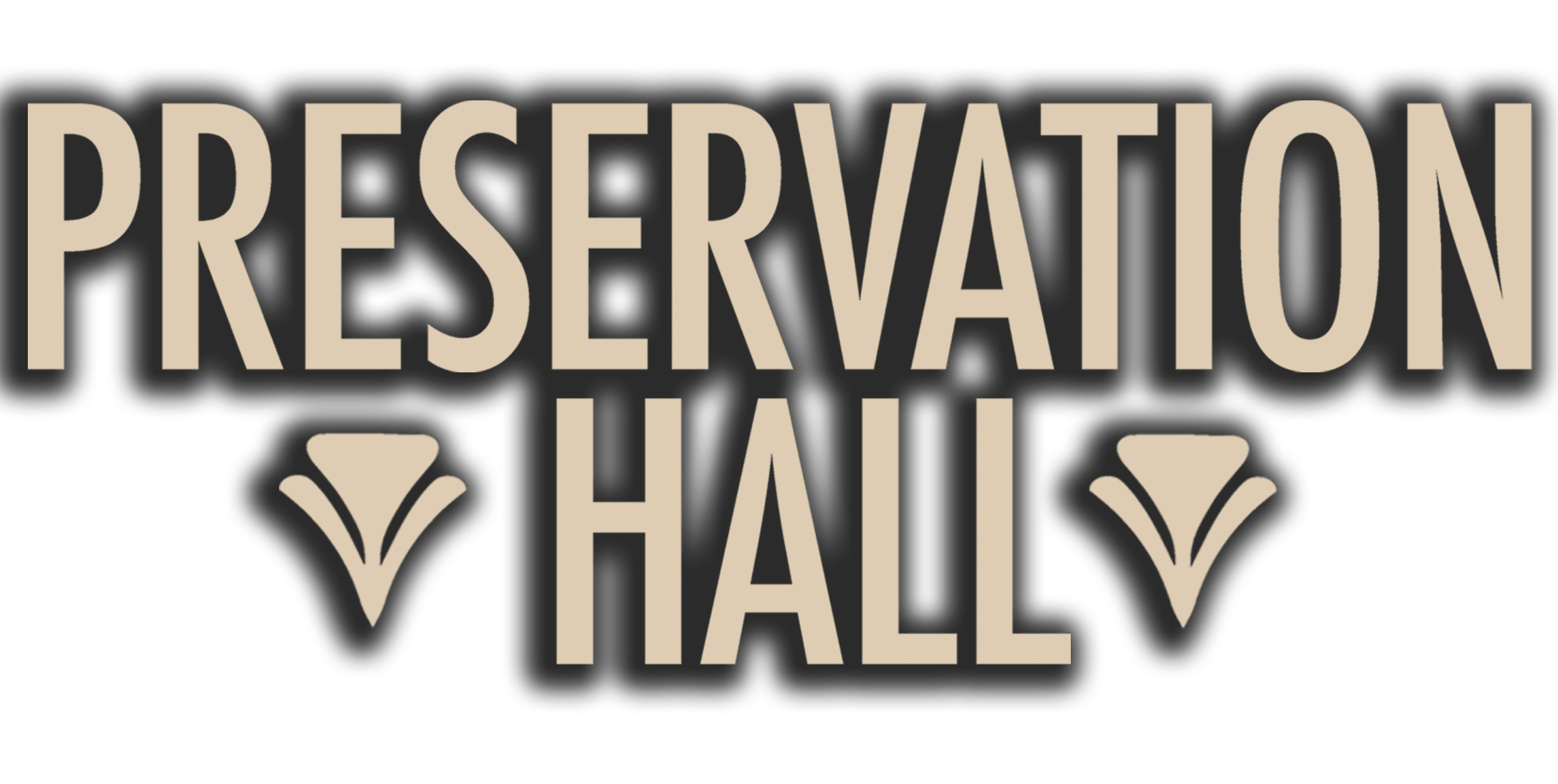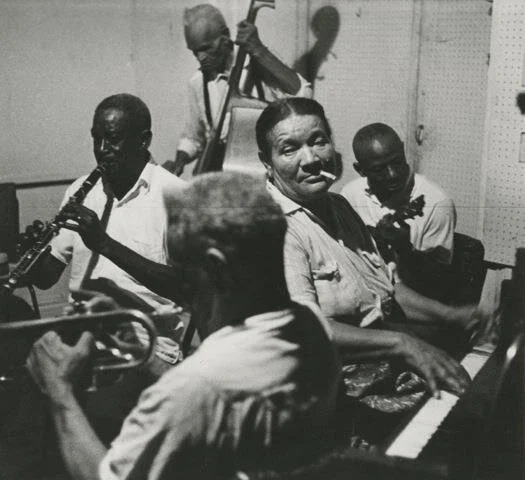#LADIESOFPRESHALL: Billie Pierce Biography
Billie Pierce (Wilhelmina Madison Goodson), pianist, vocalist and band leader, was born June 8, 1907 in Marianna, Florida, and died September 29, 1974 in New Orleans, the beloved place she called home for over 50 years.
Wilhelmina “Billie” Goodson was born on June 8, 1907, in her mother's hometown of Marianna, Florida, and raised in Pensacola where she became a key member of a large musical family, famous for its piano-playing daughters. There were six children in the family, all girls, all pianists (a seventh daughter, Maggie, died young): Mabel (b. 1899), Della (1901), Sadie (1903), Edna (1904), Billie (1907), and Ida (1909). Only one sister, Sadie, had lessons. The others learned piano from their very religious parents, Madison H. Goodson and Sarah Jenkins Goodson, who played hymns and sang in the choir in the Baptist church where Madison Goodson was a Deacon. [1] See entries on Edna Goodson, Ida Goodson, and Sadie Goodson, for additional information on the contributions of the Goodson sisters to New Orleans jazz.
As the second to the youngest Goodson sister, the piano legacy was well established by the time Billie came along. Even though Madison and Sarah Goodson disapproved of ragtime, blues, and jazz, Billie recalled that she could pick out the blues on the piano before she could talk. [2] According to Billie, the greatest piano player of the sisters was Mabel, then the next greatest was Sadie. [3] Mabel, who died at age 19, didn't play with bands, but played piano at house parties. Della played mostly for church, but also played ragtime. [4] Though her parents only played religious music, Billie and her sisters were drawn to ragtime jazz, plentiful in Pensacola when the girls were growing up. Their father wouldn't let them go hear the bands, but Billie and Edna would sometimes slip out of the house to listen to jazz. Sometimes, they would spot their sister Sadie playing in the band. [5] As with many Gulf Coast towns of the teens and twenties, local bands and traveling bands played year round. Pensacola bands playing in the ragtime jazz style included those led by George Douglas Orchestra and Joe Jesse. Traveling groups from New Orleans included the bands of Papa Celestin, Buddy Petit, and Kid Rena. [6]
There were locally grown jazz bands in Florida in those days that used the same instrumentation as the New Orleans bands, but Pierce told Bill Russell that the New Orleans bands had something special. There were, she recalled, about two bands a week from New Orleans coming through Florida, notably the one led by the celebrated cornetist Buddy Petit. [7] As a teenager Billie worked with traveling shows on the Florida legs of their tours, and also filled in for piano players at Pensacola's Belmont Theater, as did her sisters (though by 1916, Sadie had moved on to New Orleans). At the age of 15, Billie was traveling with her older sister Edna on a Florida tour with The Mighty Wiggle Carnival, owned by Jack Shaffer. The Show traveled widely across the south, but Billie recalled working only in Florida. Billie played organ, sang, and danced, and Edna danced and played with the band in the “colored minstrel show.” In Pensacola, Billie remembered working with Mack‟s Merrymakers (led by trumpet player Thomas Mack– her sister Sadie worked primarily with this band) and Mack and Mack (Billy and Mary Mack), with whom she appeared at the Belmont Theater in Pensacola. [8] She sat in with “Papa” Celestin when he came through Florida. [9] Billie‟s opportunity to accompany Bessie Smith occurred while she was working in the chorus of Smith‟s show in Florida when she was 15. The pianist was Clarence Williams, but he suffered a heart attack, and Billie sat in. She recalled that Bessie sang “Whoah, Tillie, Won‟t You Take Your Time” and “Gulf Coast Blues.” Billie liked very few singers. In one interview, she recalled liking both Ma Rainey (for her voice and power) and Bessie Smith (for her feeling), but no other singers. In another interview, she was ambivalent about Ma Rainey, but recalled liking Ida Cox and Bessie Smith. [10]
In 1929, Billie was working in a nine-piece band called the Nighthawks Orchestra in Birmingham, Alabama, when she received word that her older sister, Sadie, who was working on the steamer Madison with trumpet player Buddy Petit, had fallen ill and needed a replacement. Billie took off for New Orleans, where she played in the band on the Steamer Madison until Sadie rallied. Also in the band was Sadie‟s husband, Abbey “Chinee” Foster (drums). After Sadie‟s return, Billie worked briefly with trumpet player Lawrence Toca, then returned to Birmingham to rejoin the Nighthawks. She also toured Florida with Mack‟s Merry Makers.
Around 1930, Billie came back to New Orleans. Along with Lawrence Toca, she played with Alphonse Picou's five-piece band (along with Johnny Dave, banjo; Ernest Milton, drums; Picou, clarinet; Toca trumpet; Billie piano) at the Rialto Nightclub on Jefferson Davis Parkway. [11] She would stay with Picou for a couple of years.
Billie met De De Pierce when they were working in nearby clubs in the French Quarter. De De become the trumpet player for Sadie‟s band on the boat when Buddy Petit left to take another job. Sadie‟s band was playing at a club called Corinne on Decatur and Ursulines. At the very same intersection, Billie was leading a band that included clarinetist George Lewis at a club called the King Fish. Billie became interested in De De, but checked with Sadie first to make sure De De wasn‟t her boyfriend. Then she told him she liked him. [12] They married soon after that. De De told Bill Russell that he and Billie were inseparable, even before he lost his eyesight. [13]
Billie and De De married on March 28, 1935. Clarinetist George Lewis was the best man at their wedding, at St. Peter Claver Church. [14] The couple worked together after that, traveling with Ida Cox at one point. They played Decatur Street clubs with George Lewis (clarinet), Klebert Cagnolatti (drums), among others. [15] Billie worked with A.J. Piron at the Absinthe House. During World War II, they played at the Club Playtime in Bunkie, Louisiana. As with so many New Orleans musicians, De De had another trade to earn his living: he was a brick layer.
Billie led the band at the popular Marais Street dance spot, Luthjen's, off and on for 24 years. Describing Billie and De De‟s playing at Luthjen's, Edward Pleasants wrote, "The husband and wife team, generally with a drummer but quite often alone, settled down into a very fine musical combination. The specialty was the blues; De De's cornet tone was excellent and Billie's shouting blues voice and rolling boogie beat were, at their best, in the top rank of blues performances.” [16]
Tom Stagg heard their style as “strengthened by De De‟s background with the marching bands and Billie‟s vocals which were influenced by her days with the blues singers.” [17] In 1951, Billie made her first record on a New Orleans label owned by William Russell (American Music 641). The band included De De and Lawrence Toca on trumpet. [18] Studs Terkel, reviewing the recording for the Chicago Sun-Times was struck by the vocals contributed by “lady piano player, Billie Pierce,” which he found “vigorous, though tender.” [19]
Hard times fell on the couple in the 1950s. Billie had a stroke, which paralyzed her for several months. Around the same time, De De contracted glaucoma, which cost him his vision, as well as his ability to work as a brick layer. [20] As Billie regained her faculties and De De coped with his vision loss, the couple tried to earn a living by playing in bars as a cornet/trumpet/piano duo. When they became involved with the Preservation Hall Jazz Band in 1961, they enjoyed what William Russell called, “one of the most remarkable comebacks in New Orleans history.” [21] As band leaders at Preservation Hall, they worked throughout the 1960s and early 1970s, touring widely, and riding the revival of interest in traditional New Orleans music, what one reviewer hailed as “unmodified music of another era. It was like a renaissance in reverse". [22]
When De De died in November of 1973, he received one of the largest jazz funerals of that era. Four bands played: Preservation Hall Band, and the Olympia, Eureka, and Young Tuxedo brass bands. [23] Billie continued playing at Preservation Hall, even making one last tour, but never seemed to recover from losing De De. She eventually spent much of her time in Florida. After a brief illness, Billie Pierce died on September 29, 1974, at the age of 67, less than a year after De De's death.
During Billie Pierce's jazz funeral procession, on October 3, 1974, the Olympia Brass Band played “Just A Closer Walk With Thee,” and paused in front of the house at 1619 Galvez where Billie and De De had lived for thirty years. [24] At Corpus Christi Church, Narvin Kimball played banjo and sang, “Where He Leads Me I Will Follow,” and Sweet Emma Barrett sang “Just a Closer Walk With Thee.” After Billie was buried next to De De, the procession left St. Louis No. 2 Cemetery while the band played “Hello, Dolly.” [25]
Biography courtesy of: "A Feminist Perspective on New Orleans Jazz Women" by Sherrie Tucker commissioned by the New Orleans Jazz National Historical Park.
Featured photo courtesy of the New Orleans Jazz Club Collections of the Louisiana State Museum.

